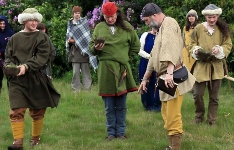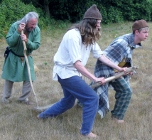by Pete Jennings
In the early 7th century, King Raedwald of the East Angles visited the Bretwalda, or most senior king in England, Ethelbert of Kent. Ethelbert persuaded him to accept Christian baptism, and sent him back to his palace in Rendlesham, Suffolk with gifts and a cross, and no doubt monks to widen the Christian mission to East Anglia. However, it is reported by Bede that he set up his new Christian altar alongside the existing Pagan ones he already had in his temple. His un-named wife remained Pagan, and when he died in about 624-5 she is believed to have given him a spectacular treasure ship burial, now known as Mound One, Sutton Hoo, in the Wuffing dynastic burial ground by the River Deben. We can conclude therefore that the new and old religions were for a short period, running alongside each other until his son Eorpwald inherited the crown.
As the semi-resident group of Anglo Saxon re-enactors at Sutton Hoo, Ealdfaeder have the opportunity to explore a number of specific activities at this best of English Saxon sites: we therefore agreed with the National Trust to re-enact a dualistic Pagan / Christian field blessing ritual, which as far as we knew had not been enacted completely in England since those times, about 1400 years ago.
The Æcerbot is preserved in the British Library Cotton Caligula A. vii manuscript. It contains both Heathen & Christian material, so is probably from the early 7th century conversion period. Some people will know it from its invocation to the harvest goddess Erce, since it is the sole source of her name to survive.
We planned it for the weekend nearest to the Summer Solstice, and augmented our regular group with some extra re-enactors from CHES and elsewhere, making an impressive encampment where crafts, food, cloth dying, games etc. could take place. The idea was to carry out the ceremony in Old English, Latin and modern translation. Fortunately, we had a mixture of modern Pagans & Christians to take the appropriate roles.
Holding a flapping piece of paper to recite from seems a bit out of period, but the ceremony is a bit long and complicated to recite from memory. An ingenious compromise was developed by our leather crafter Edwin, who created leather -bound scrolls of vellum looking paper, printed in archaic form. Just like Ræedwald before us, we had a Christian Cross plus an authentic Heathen Altar set up alongside each other.
An important part of the ritual is to take turfs from each of the four sides of the field. Since Sutton Hoo is a Schedule 1 National Monument, this would probably be illegal without government permission, so exit one furtive re-enactor with spade to a nearby heath at dead of night! “It’s not suspicious at all, walking out of a wood with a shovel over your shoulder!” re-assured my so called ‘mates.’ “If the police ask, just tell them you’ve just been burying a body!”
Turfs obtained, they were left overnight at the Christian altar, as per the ancient instructions. When the audience were gathered and welcomed, we made a brief explanation of what was to happen. Many of them had travelled hundreds of miles to see this unique event, and without any prompting became quiet and respectful.

The four turfs were born in, and oil, honey, yeast and milk were poured on each, followed by sprigs of every kind of wood in the area (excluding hardwoods and burrs, as per Exeter Book instructions.) One of the Christians then sprinkled Holy water on them, and a small twig cross was laid under each turf as it was returned to the soil with prayers.



The ploughman bowed to the East nine times and delivered an evocation, and then everybody (audience included) turned around sunwise three times, saying ‘Sanctus.’ Then grain was brought forward, with the bearer announcing that he had obtained it from a poor man, to which he had given twice its’ value in return. The specially constructed hand plough was now smeared with incense, fennel, soap and salt before cutting a first furrow, pulled by volunteers and guided by the ploughman.
Then it was the turn of a Pagan to recite a passage of 16 lines in Old English, which starts:
“Erce, Erce, Erce, eorþan modor” etc.


This was then translated as
“Erce, Erce, Erce, earth's mother, may your belly grow big in the Gods embrace etc.
Another carefully rehearsed Old English invocation was also made, followed by modern translation, then a loaf made with flour and holy water was laid in the furrow.
Finally the Christians finished with more prayers, the first in Latin:
“Crescite in nomine patris, sit benedicti”
(Grow in the name of the father, be blessed.) followed by the Paternoster & Lord’s Prayer. As it was likely that only monk/missionaries in the main would have known Latin at this time, the villagers repeated the phrases ‘parrot fashion’ after their leader.


After the ceremony we processed to the burial mounds to remember the ancestors, including King Rædwald, and honoured them with our ritual spear dance. We were accompanied by the lyre, bone pipe and percussion. Children left small floral posies and then both they and some adults had a go at the spear dance with us.
All in all, it was an ambitious project to attempt, but I believe we succeeded by the very positive feedback received afterwards on the two days we performed it. (The second time it was conducted largely in pouring rain with the Great British Public mainly refusing to give up and seek shelter – bless them!)
Æcerbot illustrated:
download pdf
Sommer solstice at Sutton Hoo:
June 2013